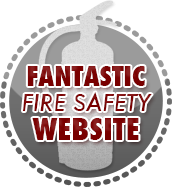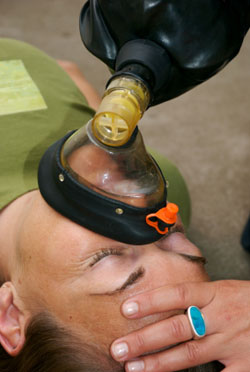Fire Extinguisher : 101
Smoke Inhalation Symptoms and Treatment
| Home |
| About Fire Extinguishers |
| Using a Fire Extinguisher |
| Fire Prevention |
| Fire Hazards |
| First Aid for Fire |
| Financial Protection |
| Biggest Fires in History |
| Firefighters |
This site was voted:

by onlinefiresciencedegree.org
(scroll to 74 on the list)
This page is intended to provide individuals with general information pertaining to treatment methods for smoke inhalation symptoms. |
Smoke caused by a fire is an asphyxiant that takes away the atmosphere’s oxygen and replaces it with dangerous chemicals such as carbon monoxide, hydrogen sulfide, and hydrogen cyanide. Fire smoke inhalation, and not body burns, causes approximately 50 to 80% of deaths related to fire disasters.
A person suffering from smoke inhalation symptoms typically requires immediate medical attention. Smoke inhalation treatment varies in accordance with the symptoms displayed by the victim.
 Smoke
Inhalation Symptoms
Smoke
Inhalation Symptoms
A person caught in a building that
is on fire will experience smoke inhalation
symptoms almost instantaneously, the most common
of which are coughing, breathing difficulties,
hoarseness, headache, upset stomach, vomiting,
sleepiness, confusion, and dark colored spit
and saliva. The victim may also develop a cherry-red
or bluish gray skin color, which is an indication
that the person is not receiving enough oxygen.
At this stage, it is possible for the person
to lose consciousness or stop breathing altogether.
Removal from the premises and immediate medical
attention is required.
Smoke
Inhalation Treatment
Anyone experiencing smoke inhalation
symptoms, especially breathing problems, excessive
coughing, and/or mental confusion, should immediately
seek smoke inhalation treatment by either calling
their medical doctor or dialing an emergency
number.
Upon arrival at the hospital, the patient is most likely to receive supplemental oxygen via a tube or mask, or undergo hyperbaric oxygen therapy if an excessive concentration of carbon monoxide is present in the blood stream. The patient may also receive various forms of medication to aid combat the symptoms.
Thereafter, a number of tests may be performed to assess the severity of the case. Typical tests include a chest x-ray for victims experiencing coughing and breathing difficulties, blood tests to determine whether or not the amount of red cells in the blood stream is adequate, and other examinations to detect possible signs of low blood pressure and changes in the pH level.
Preventing
a Disaster
There is a simple method to prevent
smoke inhalation resulting from a fire in your
home or at your work place. Installing smoke
and carbon monoxide detectors at strategic places
in your living environment is ideal. Their warning
signal allows you sufficient time to escape
in case of fire. Moreover, a proper emergency
escape route planned out beforehand will minimize
panic and disorganization.